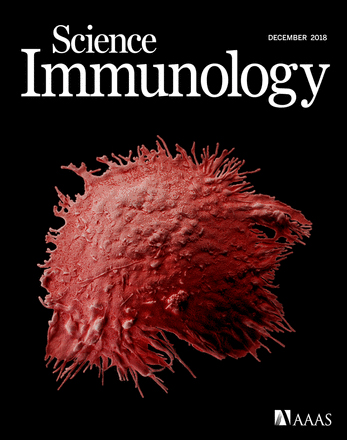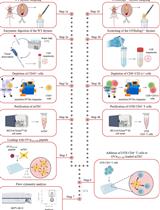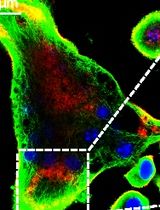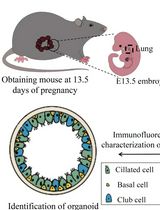- EN - English
- CN - 中文
Direct Reprogramming of Mouse Embryonic Fibroblasts to Conventional Type 1 Dendritic Cells by Enforced Expression of Transcription Factors
转录因子强化表达直接将小鼠胚胎成纤维细胞重编程为常规1型树突状细胞
发布: 2020年05月20日第10卷第10期 DOI: 10.21769/BioProtoc.3619 浏览次数: 6567
评审: Lokesh KalekarSaskia F. ErttmannVishal Nehru
Abstract
Ectopic expression of transcription factor combinations has been recently demonstrated to reprogram differentiated somatic cells towards the dendritic cell (DC) lineage without reversion to a multipotent state. DCs have the ability to induce potent and long-lasting adaptive immune responses. In particular, conventional type 1 DCs (cDC1s) excel on antigen cross-presentation, a critical step for inducing CD8+ T cell cytotoxic responses. The rarity of naturally occurring cDC1s and lack of in vitro methodologies for the generation of pure cDC1 populations strongly hinders the study of cDC1 lineage specification and function. Here, we describe a protocol for the generation of induced DCs (iDCs) by lentiviral-mediated expression of the transcription factors PU.1, IRF8 and BATF3 in mouse embryonic fibroblasts. iDCs acquire DC morphology, cDC1 phenotype and transcriptional signatures within 9 days. iDCs generated with this protocol acquire functional ability to respond to inflammatory stimuli, engulf dead cells, process and cross-present antigens to CD8+ T cells. DC reprogramming provides a simple and tractable system to generate high numbers of cDC1-like cells for high content screening, opening new avenues to better understand cDC1 specification and function. In the future, faithful induction of cDC1 fate in fibroblasts may lead to the generation of patient-specific DCs for vaccination.
Keywords: Cell reprogramming (细胞重编程)Background
Dendritic cells (DCs) are professional antigen presenting cells specialized in the recognition, processing and presentation of antigens to T cells, playing a pivotal role in the induction of adaptive immune responses and immunological memory (Merad et al., 2013). DCs can be divided into 4 main subsets: plasmacytoid DCs (pDC), producers of large amounts of type 1 interferons, monocyte-derived DCs, derived from circulating monocytes, and conventional DCs (cDC), a functionally heterogeneous subset further subdivided in conventional DCs type 1 (cDC1) and type 2 (cDC2). While cDC1s excel on priming cytotoxic CD8+ T cell responses by cross-presenting exogenous antigens on major histocompatibility complex (MHC) class I, cDC2s are specialized in the presentation of extracellular antigens to CD4+ T cells via MHC class II. This functional specialization results from stage-specific interplay between different transcription factors (TFs) that specify DC subsets. For instance, it has been shown that conditional deletion of E26 transformation-specific (ETS) family TF PU.1 in hematopoietic progenitors impacts the specification of the whole DC lineage (Carotta et al., 2010). Interferon regulatory factor 8 (IRF8) knock-out mice lack pDC and cDC1 subsets, and basic leucine zipper ATF-Like transcription factor 3 (BATF3) deficient mice have impaired cDC1 specification (Schiavoni et al., 2002; Hildner et al., 2008; Carotta et al., 2010).
Growing evidence supports the crucial role of cDC1s in initiating immune responses in the context of cancer (Bottcher and Reis, 2018), and their in vivo rarity has propelled attempts to generate cDC1 in vitro (Perez and De Palma, 2019; Wculek et al., 2019). Several strategies have been explored to generate bona fide DCs from blood monocytes or bone marrow (BM) precursors in the presence of different hematopoietic cytokines (Inaba et al., 1992; Lu et al., 1995; Lutz et al., 1999; Son et al., 2002; Naik et al., 2005; Poulin et al., 2010; Proietto et al., 2012; Balan et al., 2014; Mayer et al., 2014; Lee et al., 2015; Balan et al., 2018; Kirkling et al., 2018). However, limiting numbers of BM progenitors, together with the generation of mixed populations of DC subsets with conflicting functions, strongly limits the use of these approaches to elucidate DC development and harness cDC1s for therapy (Yona and Mildner, 2018).
Cell reprogramming offers an exciting opportunity to overcome these challenges. Through enforced expression of TFs, it is possible to reprogram somatic cells into induced pluripotent stem cells (iPSCs) (Takahashi and Yamanaka, 2006; Takahashi et al., 2007). Protocols to differentiate DCs from iPSCs have been described (Choi et al., 2009; Senju et al., 2009 and 2011; Horton et al., 2019). However, these rely on complex and long culture conditions that give rise to mixed populations of distinct DC subsets. Alternatively, somatic cells can be reprogrammed directly into other specialized cell types without transiting through pluripotency or multipotency. Mouse and human fibroblasts were directly reprogrammed into several cell types, such as neurons, cardiomyocytes and hematopoietic stem and progenitor cells, using TFs specifying target-cell identity (Pereira et al., 2012 and 2013, Xu et al., 2015).
Here, we describe a direct cell reprogramming approach to generate cDC1-like cells (induced DCs, or iDCs) by enforced expression of the TFs PU.1, IRF8 and BATF3 in mouse embryonic fibroblasts (MEFs) (Rosa et al., 2018). MEF-derived iDCs acquire DC morphology, cDC1 phenotype and transcriptional program characteristic of natural cDC1s. Functionally, iDCs acquire the ability to respond to toll-like receptor 3 (TLR3) and TLR4 stimuli, engulf protein and dead cells and, importantly, cross-present antigens to CD8+ T cells. Thus, the protocol described here enables the fast generation (within 9 days) of cDC1-like cells in vitro using a controlled and adaptable direct reprogramming approach suitable for screening studies aiming to better understand cDC1 developmental specification and functional maturation. This approach, coupled with pharmacological inhibition, gene knock-out or knock-down, will enable the discovery of regulators of DC specification acting individually or in combination (Pires et al., 2019). Employing high-content screening methodologies based on recent CRISPR-Cas9 technologies in MEFs paves the way for defining novel critical regulators of cDC1 fate and how cross-presentation ability is established de novo in multiple cell types. In the future, DC reprogramming will serve as a platform to develop immunotherapies for cancer and infectious disease.
Materials and Reagents
- 100 mm tissue culture plates (Corning, catalog number: 430167 )
- 150 mm tissue culture plates (Corning, catalog number: 430599 )
- 1.5 ml microtubes (Sarstedt, catalog number: 72.690.001 )
- 15 ml centrifuge tubes (Sarstedt, catalog number: 62.547.205 )
- 50 ml centrifuge tubes (Sarstedt, catalog number: 62.547.205 )
- Polypropylene round-bottom FACS tubes (Falcon, catalog number: 352063 )
- 150 ml bottle top vacuum filters, 0.45 μm low-protein binding (Corning, catalog number: 430625 )
- Amicon ultra-15 centrifugal filter units (Merck Millipore, catalog number: UFC903096 )
- Wild type mice (C57BL/6) or double homozygous Clec9aCre/Cre RosatdTomato/tdTomato (Clec9a-tdT) mice (Rosa et al., 2018)
- Human embryonic kidney (HEK) 293T cell line (ATCC, catalog number: CRL-3216 )
- Sterile 40 µm cell strainers (Corning, catalog number: 431750 )
- Gelatin from porcine skin type A (Sigma-Aldrich, catalog number: G1890 )
- Polyethylenimine (PEI) transfection reagent (Sigma-Aldrich, catalog number: 408727 )
- Hexadimethrine bromide (Polybrene) (Sigma-Aldrich, catalog number: H9268 )
- Doxycycline hyclate (DOX) (Sigma-Aldrich, catalog number: D9891 )
- Trypsin-EDTA (0.25%), phenol red (Thermo Fisher Scientific, catalog number: 25200-056 )
- TrypLE Express (1x) no phenol red (Thermo Fisher Scientific, catalog number: 12604-021 )
- HyClone Phosphate Buffered Saline solution (PBS) (GE Healthcare, catalog number: SH30256.01 )
- HyClone high-glucose Dulbecco's Modified Eagles Medium (DMEM) (GE Healthcare, catalog number: SH30243.01 )
- Opti-MEM reduced serum medium (Thermo Fisher Scientific, catalog number: 31985070 )
- HyClone 10,000 U/ml Penicillin 10,000 μg/ml Streptomycin Solution (Pen/Strep) (GE Healthcare, catalog number: SV30010 )
- HyClone Fetal Bovine Serum (FBS) (GE Healthcare, catalog number: SV30160.03 )
- Rat serum (GeneTex, catalog number: GTX73226 )
- Dimethyl sulfoxide (DMSO) (Sigma-Aldrich, catalog number: D8418 )
- Plasmid pMD2.G (Addgene, catalog number: 12259 )
- Plasmid psPAX2 (Addgene, catalog number: 12260 )
- Plasmid FUW-M2rtTA (Addgene, catalog number: 20342 )
- Plasmid pFUW-TetO-PIB containing a tri-cistronic cassette encoding PU.1, IRF8 and BATF3 (PIB) reprogramming factors (Rosa et al., 2018). Cell Reprogramming in Hematopoiesis and Immunity Lab, Division of Molecular Medicine and Gene Therapy, Lund University, Sweden.
- 4’,6-diamidino-2-phenylindole (DAPI) (Sigma-Aldrich, catalog number: D9542 )
- Hoechst staining solution (Sigma-Aldrich, catalog number: H6024 )
- APC conjugated anti-mouse CD45 monoclonal antibody (Biolegend, catalog number: 103112 )
- PE-Cy7 conjugated anti-mouse MHC-II monoclonal antibody (Biolegend, catalog number: 107630 )
- DMEM Complete medium (see Recipes)
- Dissociation solution (see Recipes)
- 0.1% Gelatin solution (see Recipes)
- Wash solution (see Recipes)
- Staining solution (see Recipes)
- Freezing solution (see Recipes)
Equipment
- Sterile dissecting scissors (Sigma-Aldrich, catalog number: S3146 )
- Sterile stainless steel forceps (Sigma-Aldrich, catalog number: Z168777 )
- Freezing container Nalgene Mr. Frosty (Sigma-Aldrich, catalog number: C1562 )
- Hemacytometer cell counting chamber (Marienfeld Superior, catalog number: 13444890 )
- 4-16K Refrigerated centrifuge (Sigma)
- FACSCanto II flow cytometry analyzer (8-color, blue/red/violet) (BD Biosciences)
- BD FACSAria III cell sorter (BD Biosciences)
- Heracell 150i CO2 incubator (Thermo Scientific)
- ScanLaf Mars class 2 laminar flow hood (LaboGene)
- IX70 inverted tissue culture microscope (Olympus)
- Celldiscoverer 7 inverted microscope (Zeiss)
Software
- GraphPad PRISM 6, https://www.graphpad.com/
- FlowJo V10, https://www.flowjo.com/
- ZEN 3.1 (blue edition), https://www.zeiss.com/
- Adobe Photoshop CS6, https://www.adobe.com/se
Procedure
文章信息
版权信息
© 2020 The Authors; exclusive licensee Bio-protocol LLC.
如何引用
Readers should cite both the Bio-protocol article and the original research article where this protocol was used:
- Rosa, F. F., Pires, C. F., Zimmermannova, O. and Pereira, C. F. (2020). Direct Reprogramming of Mouse Embryonic Fibroblasts to Conventional Type 1 Dendritic Cells by Enforced Expression of Transcription Factors. Bio-protocol 10(10): e3619. DOI: 10.21769/BioProtoc.3619.
- Rosa, F. F., Pires, C. F., Kurochkin, I., Ferreira, A. G., Gomes, A. M., Palma, L. G., Shaiv, K., Solanas, L., Azenha, C., Papatsenko, D., Schulz, O., Reis e Sousa, C. and Pereira, C. F. (2018). Direct reprogramming of fibroblasts into antigen-presenting dendritic cells. Sci Immunol 3(30).
分类
发育生物学 > 细胞生长和命运决定 > 分化
免疫学 > 免疫细胞分离 > 抗原递呈细胞
细胞生物学 > 细胞工程 > 慢病毒递送
您对这篇实验方法有问题吗?
在此处发布您的问题,我们将邀请本文作者来回答。同时,我们会将您的问题发布到Bio-protocol Exchange,以便寻求社区成员的帮助。
提问指南
+ 问题描述
写下详细的问题描述,包括所有有助于他人回答您问题的信息(例如实验过程、条件和相关图像等)。
Share
Bluesky
X
Copy link












